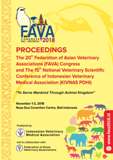SA-5 Case report: Mammary Gland Tubulocarcinoma on Dog Miniature Dachshund at Animal Hospital University of Brawijaya Indonesia
Abstract
In 1 study of 2000 dogs In America, 23% were found to have died due to cancer [1]. Mammary tumors are one of the most common neoplasms of female dogs [2]. This tumor mainly affects middle-aged dogs (9 to 11 years), with an increased incidence that begins at about 6 years old [3]. Sex steroid hormones are thought to have a major role during the early stages of carcinogenesis due to the presence of estrogen and progesterone receptors in higher proportions in most mammary tumours. [3,4]. In addition to hormonal influences, the use of products containing medroxyprogesterone acetate (progestin and estrogen combinations) to prevent estrus in dogs is also associated with an increased incidence of mammary tumors [5]. Mammary tumors can interfere with the physiological appearance and physiological function of the body. This report aims to describe cases of mammary tumors in dogs supported by hematology laboratory examination, blood biochemistry, cytology and histopathology.

